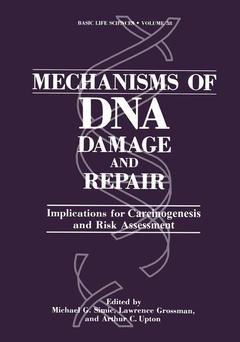Mechanisms of DNA Damage and Repair, Softcover reprint of the original 1st ed. 1986 Implications for Carcinogenesis and Risk Assessment Basic Life Sciences Series, Vol. 38
Langue : Anglais
Auteurs : Simic Michael G., Grossman Lawrence, Upton Arthur C., Bergtold David S.

This book is based on the papers presented at the conference on "Mecha nisms of DNA Damage and Repair: Implications for Carcinogenesis and Risk Assessment," held at the National Bureau of Standards on June 2-7, 1985, This volume deals with mechanisms of DNA damage and repair at the molecular level; consequences of unrepaired or misrepaired damage, with major emphasis on carcinogenesis; drugs which bind selectively to altered and potentially damaging DNA sequences; and potential utilization of DNA damage as an endpoint for assessing risks of UV light, ionizing radiations, chemicals, drugs, and hazardous agents in foods. Because the induction of mutations by radiation and genotoxic chemicals has been observed to follow one-hit kinetics in some instances, it is generally assumed that any level of exposure to a DNA-damaging agent may increase the risk of genetic disease or cancer in an exposed population. At the same time, however, there is evidence that although the DNA of living cells is continually damaged by natural background radiation, free radicals, and other naturally occurring processes, most of the damage is normally repaired.
to Mechanisms of DNA Damage and Repair.- History of Radiation Biology from a Personal Point of View.- DNA Damage.- Mechanisms of Damage.- Comparison of Mechansms for DNA Strand Break Formation by the Direct and Indirect Effect of Radiation.- Eletron Spin Resonance Studies of the Mechanism of Radiation Damage to DNA.- Free Radical Mechanisms of DNA Base Damage.- Peroxyl Radicals of Nucleic Acids and Their Components.- Radiation-Induced Peroxidation of DNA and Effects of Redox-Active Agents.- The Radiation Chemistry of the Purine Bases Within DNA and Related Model Compounds.- Bacteriophage DNA as a Model for Correlation of Radical Damage to DNA and Biological Effects.- Damage in Cells.- Ultrafast Chemical Repair of DNA Single and Double Strand Break Precursors in Irradiated V79 Cells.- Assessment of DNA Damage by Filter Elution Assays.- DNA Modification by Sulfur Mustards and Nitrosoureas and Repair of These Lesions.- Intragenomic Localization of Carcinogen-DNA Damage.- Ionizing Radiation Induced DNA Damage: Identities and DNA Repair.- Effects of LET? on the Fate of DNA Damage Induced in Rabbit Sensory Cells In Situ: Fundamental Aspects.- Radiation Damage to DNA in Various Animal Tissues: A Comparison of Yields and Repair In Vivo and In Vitro.- Differential Regulation of Base and Nucleotide Excision Repair in Mammalian Cells.- Immediate and Repair Induced DNA Double Strand Breaks in Mammalian Cells.- DNA-Protein Cross-Links: New Insights into their Formation and Repair in Irradiated Mammalian Cells.- DNA-to-Protein Crosslinks and Backbone Breaks Caused by Far-and Near-Ultraviolet and Visible Light Radiations in Mammalian Cells.- DNA Binding Drugs.- Sequence Specificity and Biological Consequences of Drugs that Bind Covalently in the Minor Groove of DNA.- Molecular Recognition of DNA Binding Agents: High-Field 1H and 31P One- and Two-Dimensional NMR Studies on the 1:1 Intercalation Complexes of Mitoxantrone with selected Oligodeoxyribonucleotides.- DNA Binding and Biological Properties of Bis and Tris Intrcalating Molecules.- Novel Types of DNA-Sugar Damage in Neocarzinostatin Cytotoxicity and Mutagenesis.- DNA-Drug Binding and Control of Genetic Information.- Computer-Aided Design of New DNA Intercalators.- DNA Repair and Consequences.- Differential Expression of SOS Genes in an E. Coli Mutant Producing Unstable LexA Protein Enhances Excision Repair But Inhibits Mutagenesis.- Mutagenic DNA Repair in Bacteria: The Role of UmuDC and MucAB.- The Repair of Pyrimidine Dimers Via a DNA-Glycosylase Mechanism.- The Involvement of an E. Coli Multiprotein Complex in the Complete Repair of UV-Damaged DNA.- Pyrimidine Dimer Induced Alteration of DNA Tertiary Structure Evidence for Unwinding and Shortening.- Mismatch Correction.- Molecular Approaches to the Study of Nucleotide Excision Repair in Eukaryotes.- Restoration of DNA Repair in UV-Sensitive Chinese Hamster Ovary Cell by the denV Gene from Bacteriophage T4.- The Adaptive Response of Mammalian Cells to Alkylating Agents.- DNA Glycosylases in DNA Repair.- Apurinic Sites as Common Intermediates in Mutagenesis.- The Repair of Uracil-Containing DNA.- Metabolic Consequences of DNA Damage: The Role of Poly (ADP-Ribose) Polymerase as Mediator of the Suicide Response.- DNA Damage, DNA Repair and Induced Mutagenesis: Some Enzymological and Structural Considerations.- Mechanisms of Mutagenesis of E. Coli by Ultraviolet Light.- Activation of H-ras-1 Oncogenes by Chemical Carcinogens.- Activation of the c-myc Oncogene.- Salmonella Tester Strains: Mutational Targets and Correlation with Animal Carcinogenicity and Teratogenicity.- Mechanisms of Spontaneous Mutagenesis: Clues from Mutational Specificity.- Risk Assessment.- Use of Gradient Denaturing Gels to Determine Mutational Spectrum in Human Cells.- Urinary N-Nitrosamino Acids as Indices of Endogenous Formation of N-Nitroso Compounds.- Application of Monoclonal Antibodies to Monitor Human Exposure to Aflatoxin Bl.- Blood Proteins as Carcinogen Dosimeters.- Development of an Avidin-Biotin Amplified Enzyme-Linked Immunoassay for Detection of DNA Adducts of the Human Bladder Carcinogen 4-Aminobiphenyl.- Intragenomic Heterogeneity in DNA Damage Processing: Potential Implications for Risk Assessment.- The Role of Pharmacokinetics in Risk Assessment.- Immunologic Quantification of Carcinogn-DNA Adducts.- Interpretation of Genotoxicity Data in Assessing the Risks of Genetic Diseases.- Background Levels of DNA Damage in the Population.- Use of Models in Low-Dose Extrapolation.- Problems in Interspecies Comparisons.- The Time to Tumor Approach in Risk Assessment.- The Role of Nutritional Factors in Cellular Protection Against DNA Damage, Altered Gene Expression and Malignant Transformation.- The Role of Risk Assessment in Food Safety Policy.- Contributors.
Date de parution : 12-2012
Ouvrage de 578 p.
17.8x25.4 cm
Disponible chez l'éditeur (délai d'approvisionnement : 15 jours).
Prix indicatif 105,49 €
Ajouter au panierThème de Mechanisms of DNA Damage and Repair :
Mots-clés :
DNA; DNA damage; Nucleotid; Protein; cancer; cells; ionizing; kinetics; mutation; paper; polymer; population; radiation; risk assessment; ultraviolet
© 2024 LAVOISIER S.A.S.
